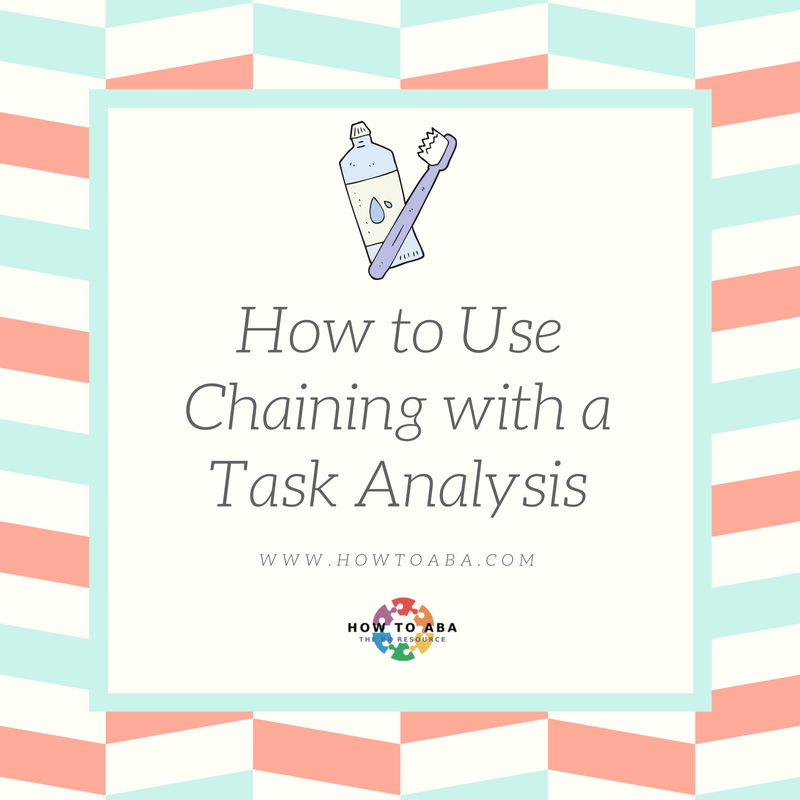
One of the greatest tools in our toolbox is the ability to break down larger skills into smaller, more attainable steps (and then reinforce each step along the way!). There is a lot that can be accomplished through this Task Analysis teaching method, especially in the area of self-help and independence.
What is a Task Analysis?
A task analysis is created by breaking down complex tasks into a sequence of smaller steps. For example, brushing teeth would be broken down into all the steps involved (eg: get toothbrush, rinse toothbrush, put on toothpaste, etc). Instead of presenting the entire, complex task, each individual step is taught using chaining procedures.
How to Create a Task Analysis
The best way to create a task analysis is to do the task! If you’re teaching a student to wash his hands, wash your hands and record each step you perform in the process. Be specific! Make sure that it’s individualized to your student and location. For example, some bathrooms have paper towels for drying hands and some have air dryers – incorporate the one your student will encounter.

Example of a task analysis
Be Flexible
Try it out with your student and be prepared to make changes. I had a student who didn’t rinse his toothbrush before putting toothpaste on it even though it was a step in the chain. It wasn’t really worth re-teaching because he was independent with the steps so we changed the task analysis to reflect his preference.
Once the task analysis is created, we can use forward chaining or backwards chaining to teach each step.
Forward Chaining
This process is when the first step of the chain is completed by the learner and the rest of the steps are either not completed or prompted through. This is a great tool for situations that a student may need to be desensitized towards, like haircuts or the dentist. For example, before a students first trip to the dentist, we would teach her to tolerate only lying down in the “dentist” chair. Once she can do that successfully (i.e., without protesting), we would have her lie down AND put on a dental bib. Very slowly, we are adding steps onto the sequence as she is tolerating them. By breaking it down into smaller steps and systematically introducing each step, the student is able to feel successful and gets a lot of practice opportunities before the real deal. As the student masters (or tolerates) the first step, subsequent steps are introduced in order.
Backwards Chaining
During backwards chaining, the learner only completes the last step. She can be prompted through the previous steps or not expected to complete them at all. Once she reaches mastery with the last step, the second last step is introduced and then the third last step, etc. We often use backwards chaining when teaching hand washing. At first, the learner is taught to complete the last step of the process (i.e., throw out the paper towel) and once that is independent, she is taught to wipe her hands and then throw out the paper towel, etc.
Other Uses for a Task Analysis
We’ve taught many life skills through the use of a task analysis – anything from playing a board game to a morning routine to going to the dentist. Breaking down the larger tasks also helps up see where our student might be struggling and what areas need to be worked on. Maybe the student isn’t able to squeeze the toothpaste and that is what is holding back his independence. We can put in a separate program to teach this skill and hopefully increase his chances of mastering it in the task analysis. We are all about promoting independence for our learners and a task analysis is a great way to do so!
Check out our YouTube Video on Life Skills – Chaining here!



Pingback: Tackle Big Skills In Baby Steps - How to ABA
Pingback: Shaping Behavior Using ABA - How to ABA
Pingback: Behavior Chain in ABA - How to ABA
Pingback: ABA in the Classroom - How to ABA